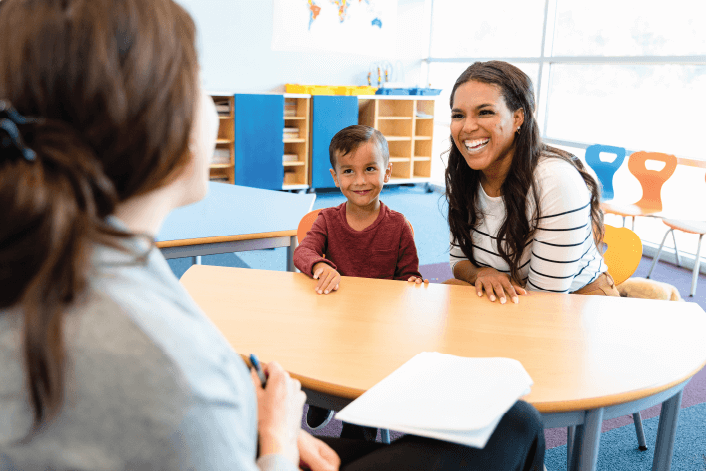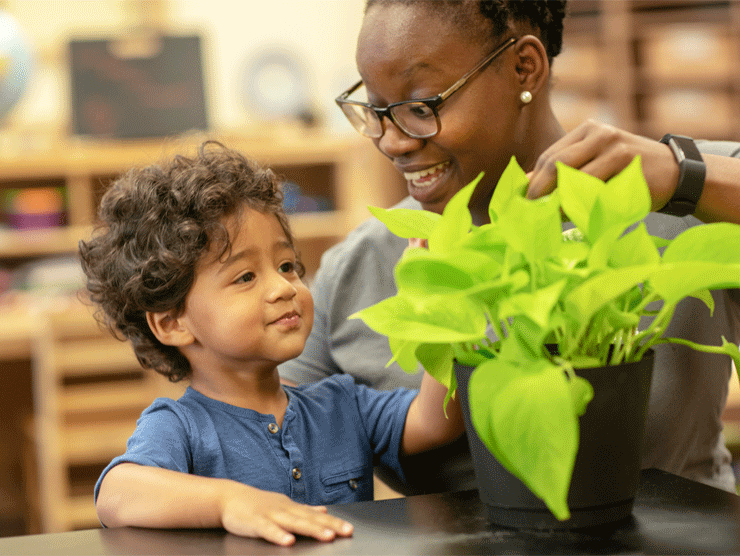The spaces where we live, work, and learn each day have a profound impact on our experiences. They have the power to cultivate a strong sense of self, belonging, inspiration, and motivation. This is especially true for students in schools and child care centers.
At Bright Horizons, our Discovery Driven Learning® framework emphasizes the importance of the classroom environment. Our classrooms are more than four walls – they’re carefully designed Learner-Centered Environments, drawing inspiration from educational approaches like Montessori and Reggio Emilia, that spark curiosity, creativity, and confidence. Every detail – from natural light to the placement of bookshelves – plays a role in how children learn, play, and feel each day.
5 key features of a Bright Horizons classroom environment
- Welcoming, personalized spaces that reflect the child’s emerging and evolving interests and create a sense of belonging. We aim to reflect children’s and families’ lives and include real, meaningful items, such as the children’s photographs, books, and work samples.
- Thoughtful layouts that include areas for reading and writing, messy art, dramatic play, science exploration, math, and group projects. Our teachers work to create places for “protected” play away from traffic paths where children can delve into projects and play without interruption. Each of these spaces offers materials in low, open shelves or accessible containers which promote children’s independence over their choices – a principle shared with Montessori classrooms.
- Natural, high-quality materials like wood, stone, wicker, and safe plants, as well as real household items, e.g., real dishes and silverware for mealtimes. These materials show respect for children’s competencies and support a calm, peaceful learning space.
- Learning on display with children’s projects, writing, and artwork thoughtfully arranged at their eye level, giving them ownership of their space. Making children’s learning visible is a big part of Discovery Driven Learning because children feel respected, seen, and heard when they see their work displayed in meaningful ways around the room.
- Bright, beautiful environments with natural light, soft lamps, organized uncluttered spaces, and carefully curated displays such as a vase with flowers or art materials sorted and organized by color in baskets or trays. The soft lighting creates a home-like ambiance suitable for learning.
Our goal is to set children up for success and independence. A classroom should be designed at the children’s eye level, meaning all the materials and displays are at children’s level, and not towering over them or out of reach. When we design spaces in this way, children feel respected and competent. Learning materials are easy to access and visually organized on low, open shelves and containers. These shelves and baskets are labeled with images and names of each material, so children begin to identify print and the meaning it carries as well as feel competent in being able to independently clean up.
Made well-known through the Reggio Emilia philosophy of education, three teachers guide your child’s early learning years: the parent, the teacher, and the environment. What that really means is simple: the classroom matters. Our classrooms are intentionally designed to be safe, inspiring, and engaging spaces where children feel at home and ready to learn.
Why a Bright Horizons child care center is a great place for childhood
A Bright Horizons classroom is more than a place to learn – it’s a place to grow, explore, and belong. By designing environments in a thoughtful way, we help children develop independence, confidence, and a lifelong love of learning. By curating spaces that are designed specifically for your children, they are free to discover their full potential.
Ready to start a conversation with a center director at your local Bright Horizons? Find a center near you.





